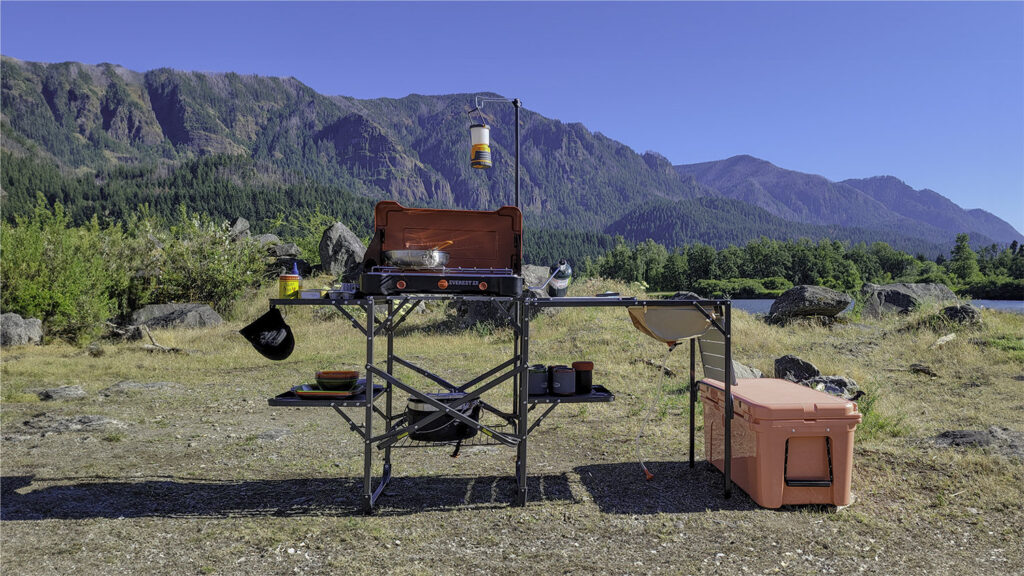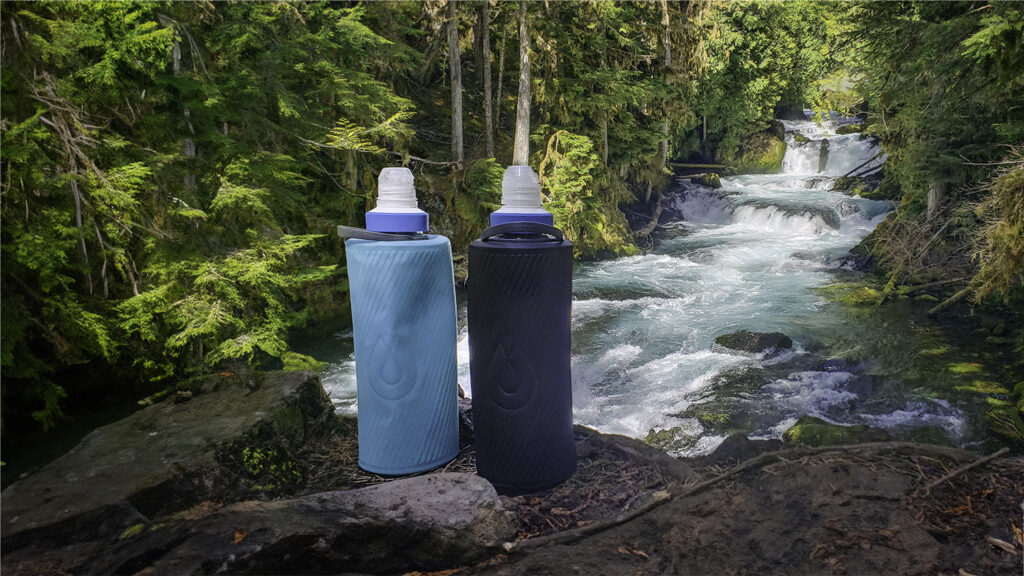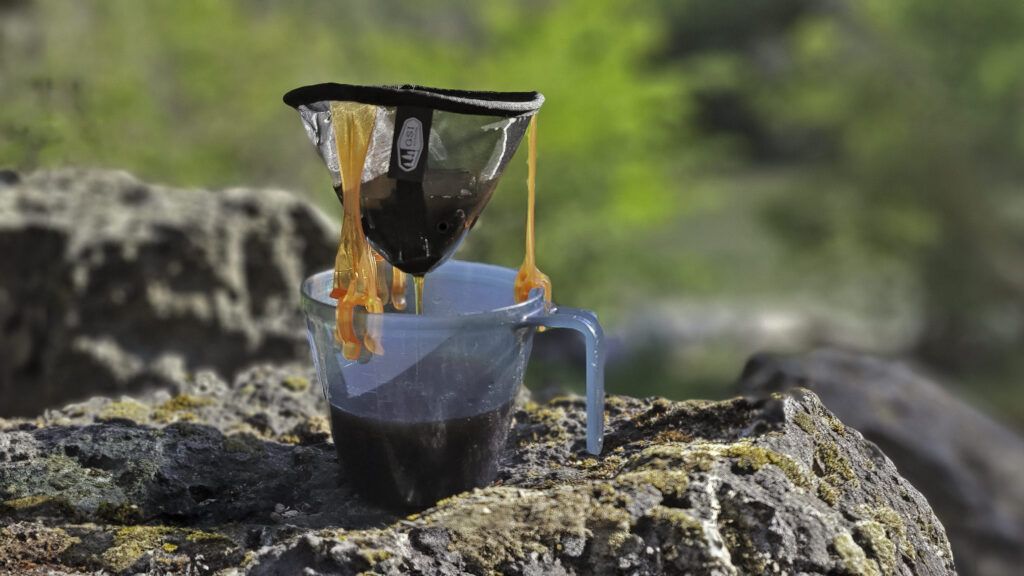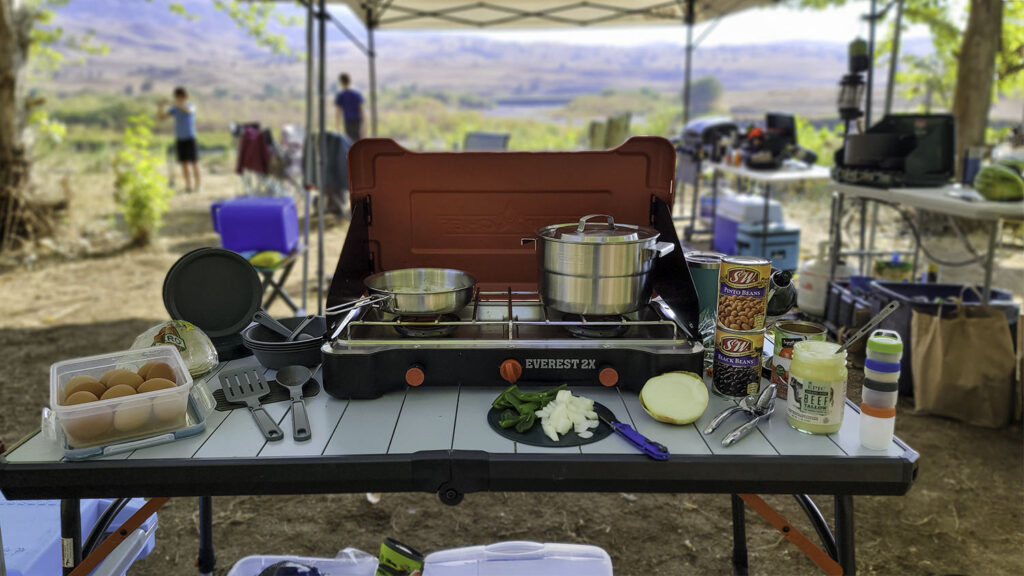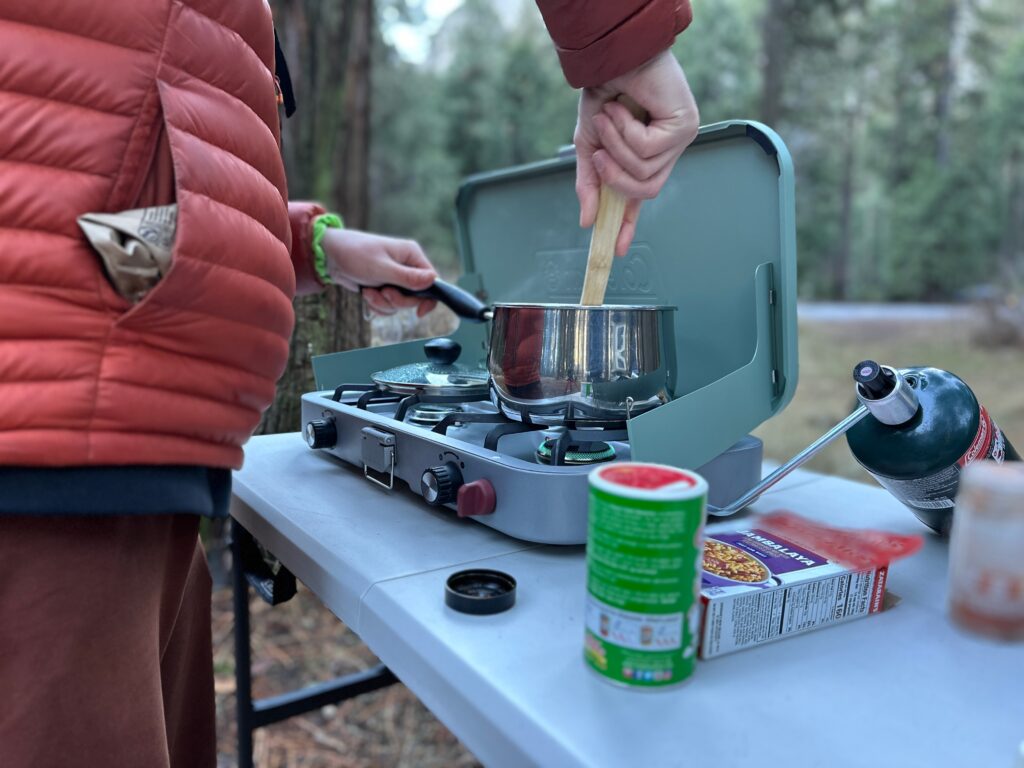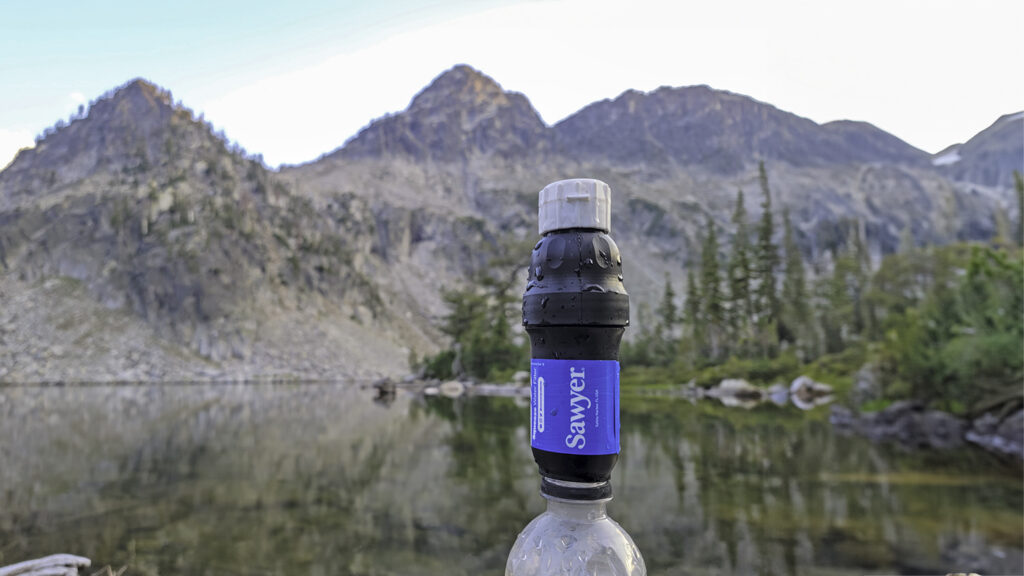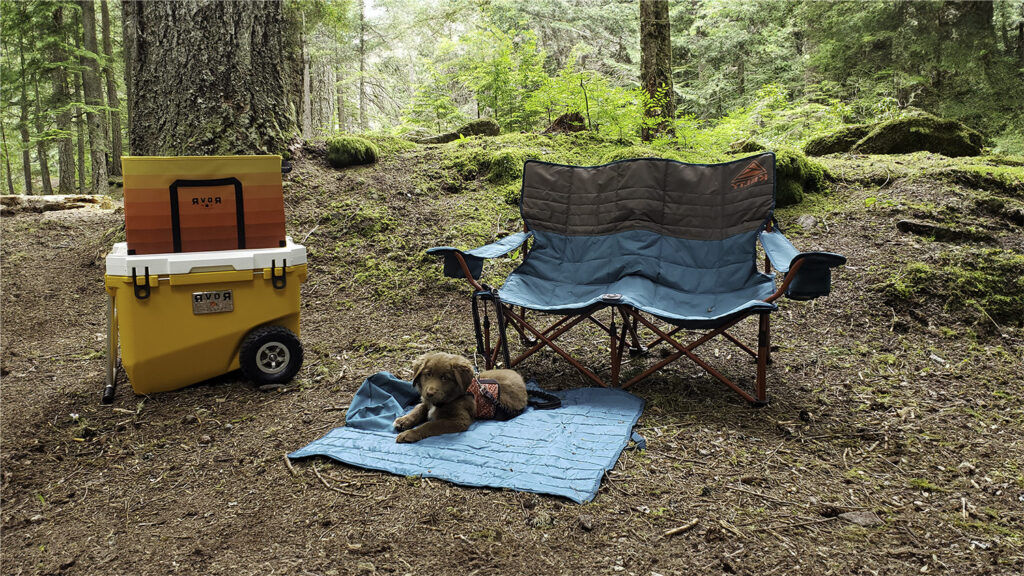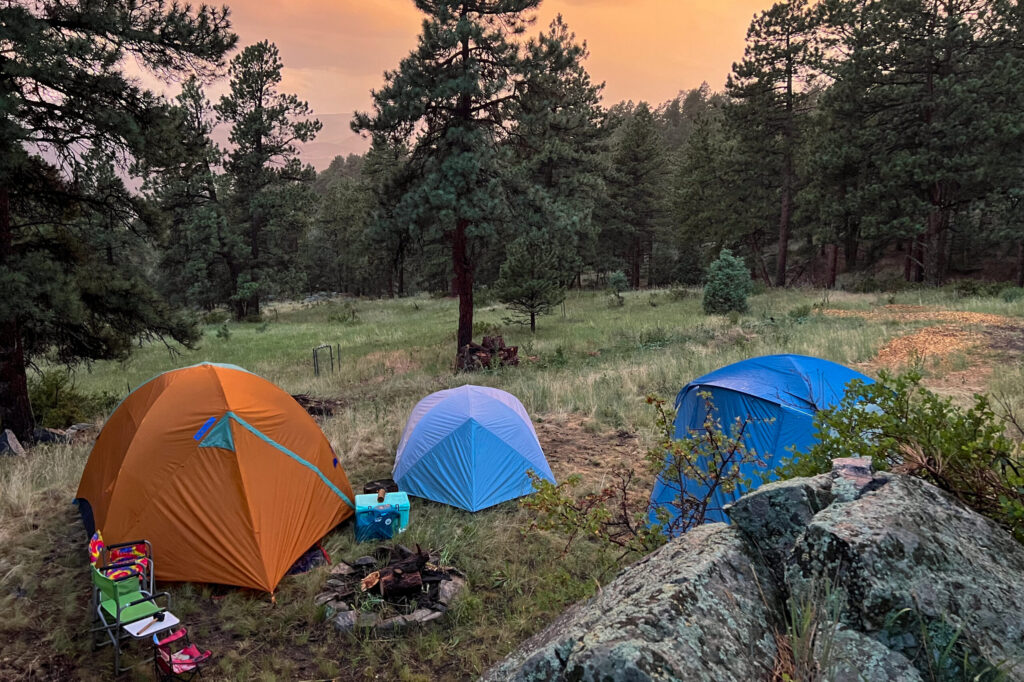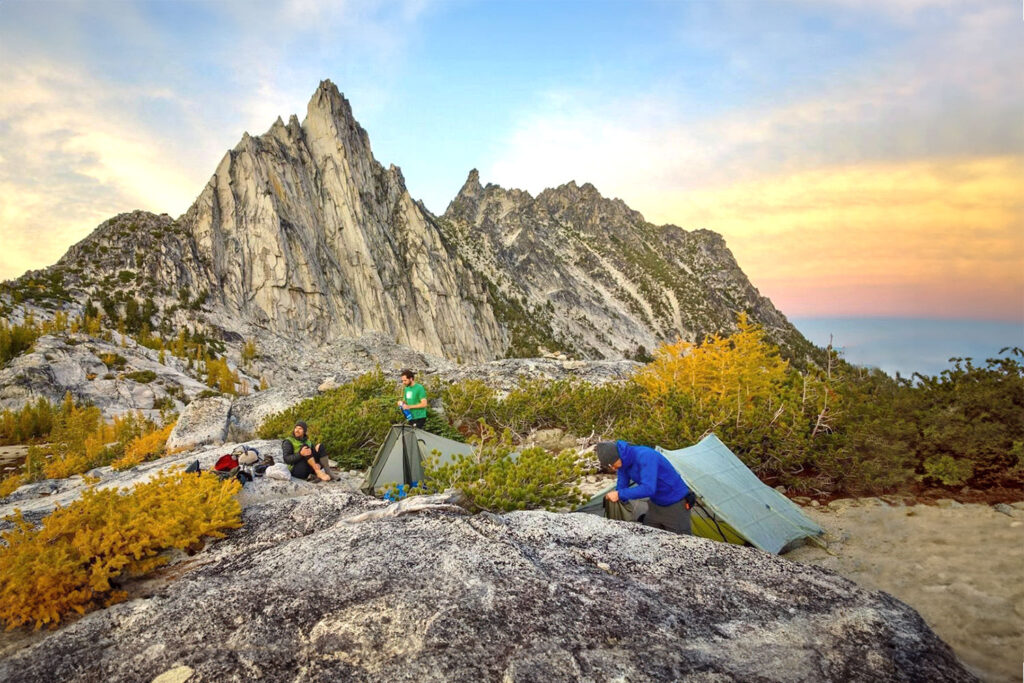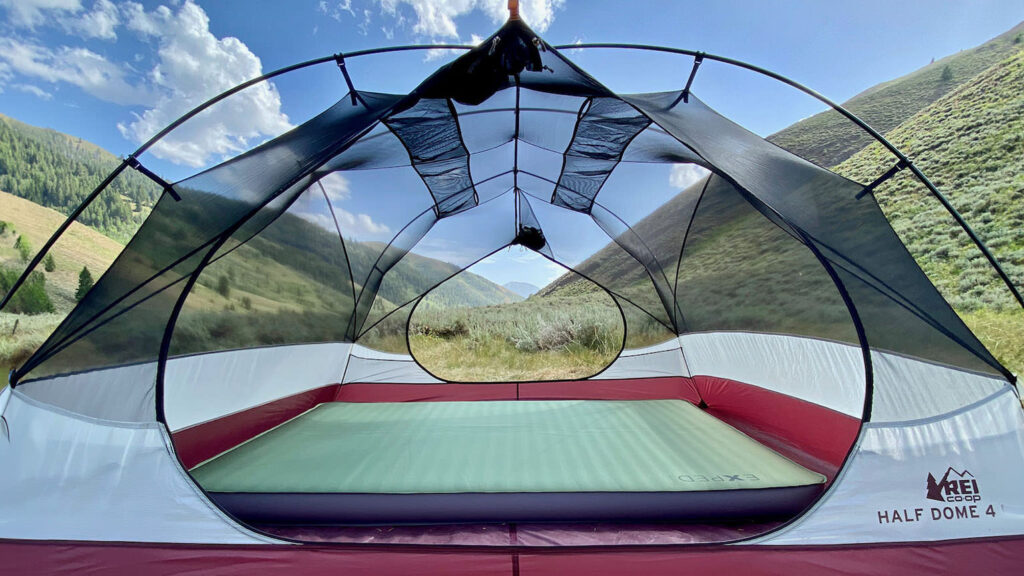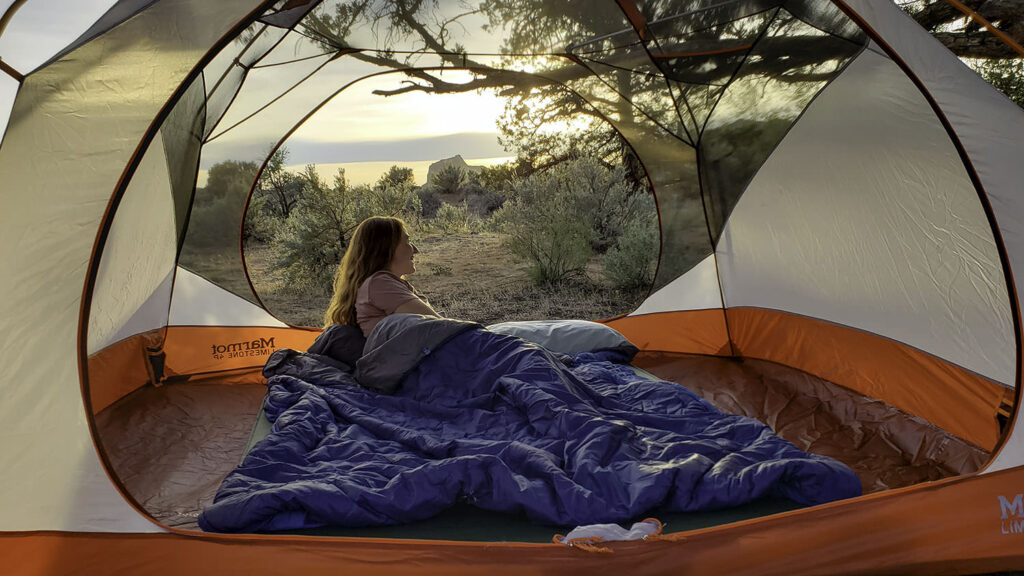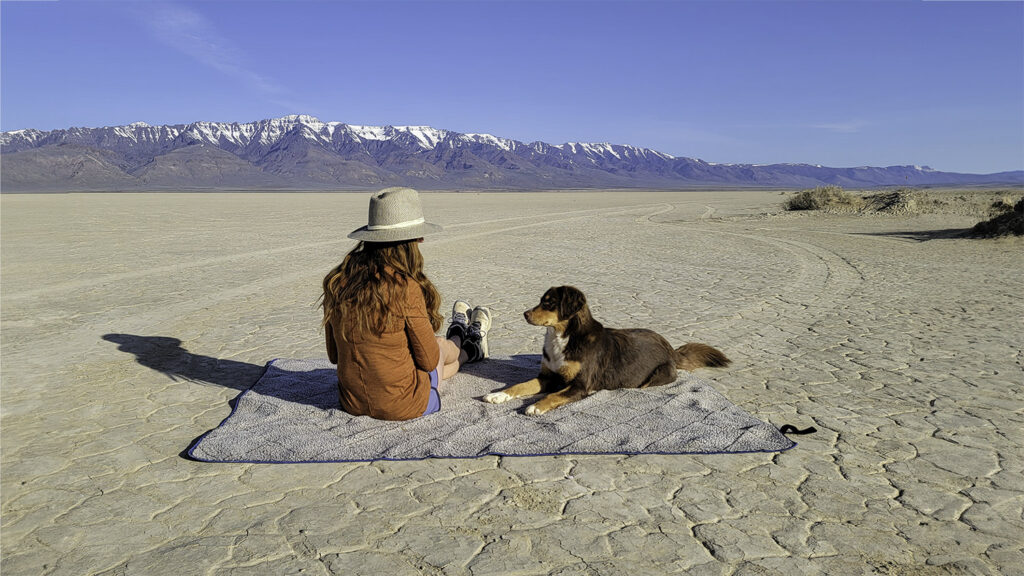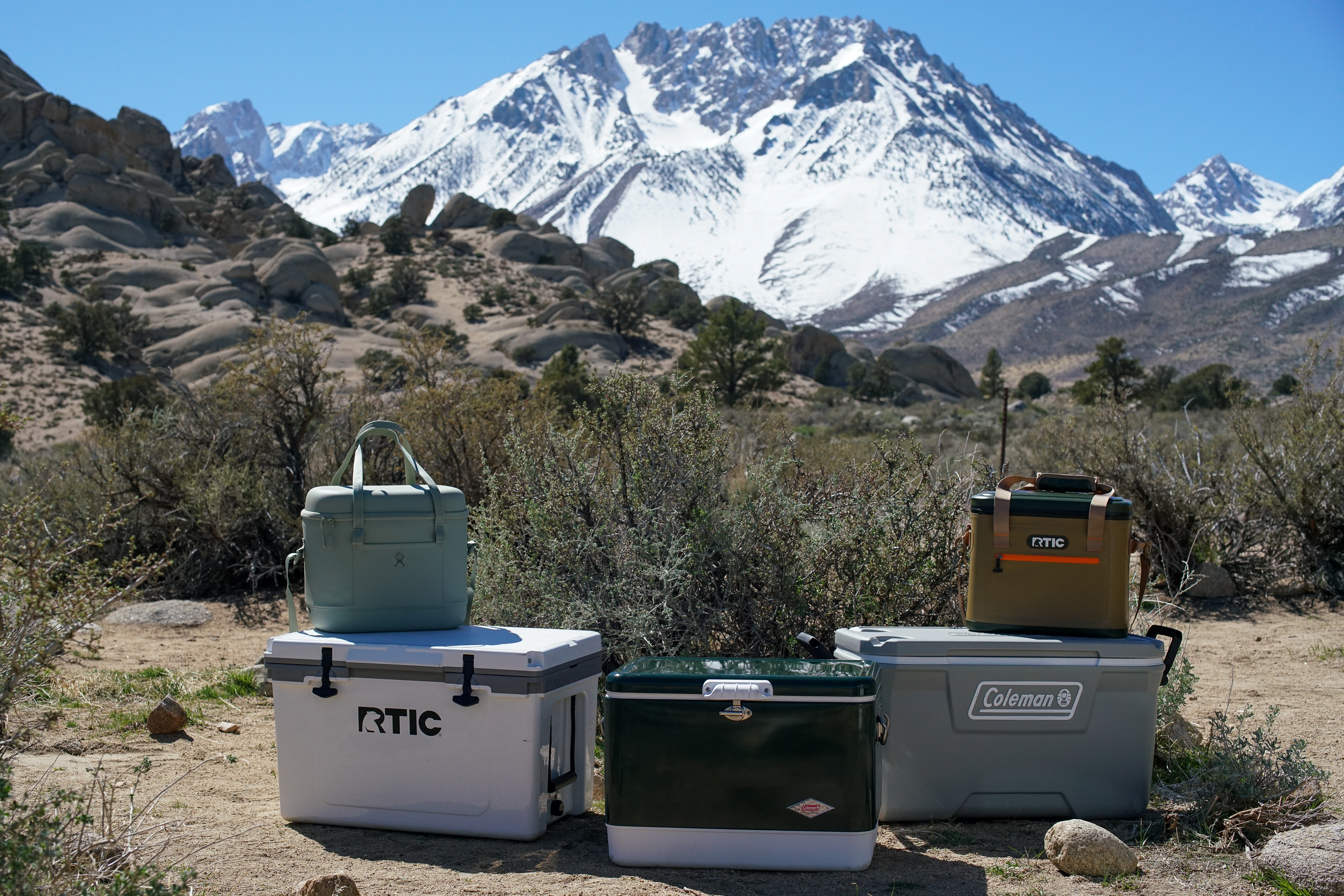
As the weather warms up, a cooler becomes an essential tool for keeping food and beverages cold during everything from a day on the water to multi-day car camping trips. Whether you’re after a cold beer or a camp chef wanting to use fresh ingredients, a good cooler will keep everything at the right temperature and has a design tailored to meet the needs of all your outdoor adventures.
Selecting top performers from brands like YETI, RTIC, and Coleman, we tested the most highly rated coolers during warm spring days in the high desert of California’s Eastern Sierra.
We took them on sunny afternoons bouldering, bumping down washboard roads in a camper van, and even to work to see how well they kept our lunches cool. We examined each cooler’s insulating capabilities and observed factors like durability, volume, and portability, testing both form and function to see how well these coolers compared against each other.
And for more info, check out some of our other popular gear guides:
Quick Picks for Coolers
Check out this quick list of our favorites if you’re in a hurry, or continue scrolling to see our full list with in-depth reviews.
Best Cooler Overall:YETI Roadie 48 ($400)
Most Durable and Insulated:XSpec 60QT ($220)
Standout Soft Cooler: YETI Hopper Flip 12 ($250)
Top Pick for Longer Trips: YETI Tundra 65 ($350)
Biggest Bang for Your Buck: Coleman 316 Series 70QT ($85)
Lightest Weight High Volume Cooler: RTIC Ultralight 52 ($200)
Best Waterproof Soft Cooler: RTIC Soft Pack Cooler ($125)
Most Portable Soft Cooler: REI Cool Trail Split Pack Cooler ($85)
Stylish and Budget-Friendly: Coleman Steel Belted Cooler ($200)
Most Affordable Soft Cooler: Hydro Flask Carry Out 20L ($90)
What’s new
The CleverHiker team has been on countless camping trips to test how the newest coolers on the market stack up against our favorites. We welcomed several new additions that proved impressive options for all your chilling needs:
- The YETI Roadie 48 became the top choice for its impressive portability and insulation, all while offering a larger capacity for bigger gatherings or longer trips.
- We added the RTIC Ultralight 52 to the lineup because of its lightweight design that enhances portability for larger coolers, all while delivering days of insulation.
- The Xspec 60QT earned a spot on our list for its rugged durability thanks to its rotomolded construction that kept ice for nine days.
- With its durable waterproof design, the RTIC Soft Pack Cooler is a perfect choice for a day on or in the water.
Cooler Overall Testing Scores
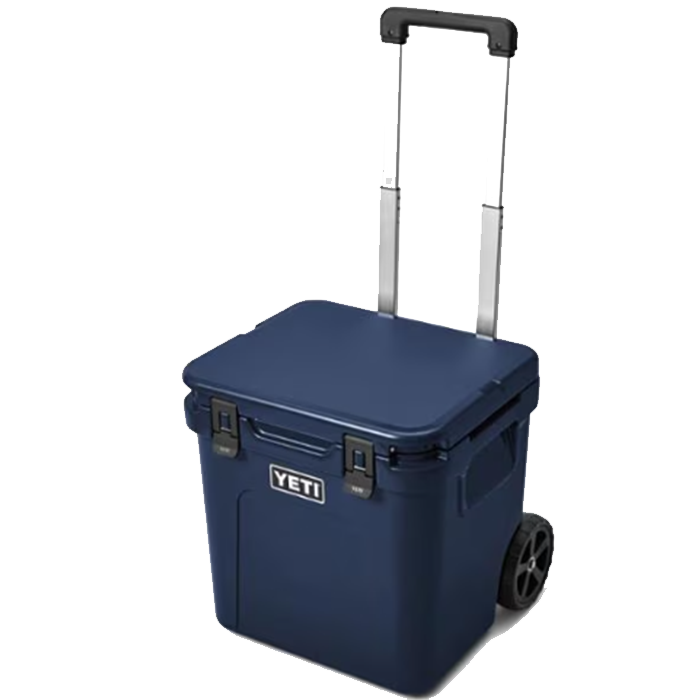
YETI Roadie 48
Best Cooler Overall
CleverHiker Rating: 4.9/5.0
Price: $425
Empty Weight: 28 lb. 5 oz.
Volume: 45 qt.
Sizes: 15, 24, 32, 48, 60 qt.
Pros
- Burly wheels for easy transport
- Tons of interior space
- Ample accessories available
- Retains ice for 10 days
Cons
- Expensive
- Non-rotomolded insulation is slightly less effective
From coolers to thermoses, YETI is known for its excellent insulation, and the YETI Roadie 48 lives up to the brand’s reputation. With its all-around unbeatable performance, the Roadie is a cooler suitable for everything from gatherings to your next multi-day car camping trip.
In contrast to the rotomolded design typical of many YETI coolers, the Roadie uses pressure-injected polyurethane for insulation, which helps keep it lighter. A built-in freezer gasket in the lid creates a tight seal that enhances cold retention, and in our testing, ice remained intact for 10 days. It took 11 days to reach 40 degrees Fahrenheit (the limit for safely storing food) and 12 days to reach 50 degrees (the ideal maximum temperature for chilled beer).
Because of manufacturing limitations, non-rotomolded coolers are typically not made as a single piece, which creates seams that could weaken the structure over time. However, the Roadie features a one-piece construction free from these common weak spots, making it a more durable cooler built to handle tough conditions.
Unlike any of the other coolers reviewed, the Roadie is wheeled, enabling maximum portability. The wheels are made as solid, single-piece units that are puncture-resistant. We rolled the cooler over gravel, dirt, concrete, and sand with little difficulty. A periscope handle extends to allow the cooler to be pulled. Our only complaint was that the handle is not adjustable and has only one extension length. However, we loved how easily we could pull a fully loaded cooler and avoid the strain of carrying it by hand.
The Roadie features a more cube-like design compared to the long rectangular shapes of other coolers. Favoring height over length, it easily fits upright 2-liter bottles or wine bottles and offers a generous 76-can capacity. Its ample storage space provides plenty of room for multiple people or several days’ worth of perishable supplies.
In their signature style, YETI offers the Roadie in a variety of colors and sizes. The cooler includes an interior basket, ideal for organizing and separating specific items, and YETI also sells accessories like a divider and a cup caddy to fully customize the Roadie to your needs.
Some may hesitate at the YETI’s high price, but considering its rugged durability, extensive features, and superb insulation, the YETI Roadie is built for outdoor use and designed to last. It’s an investment in a versatile cooler that’s ideal for everything from casual outings to camping trips and won’t need replacing for many years.
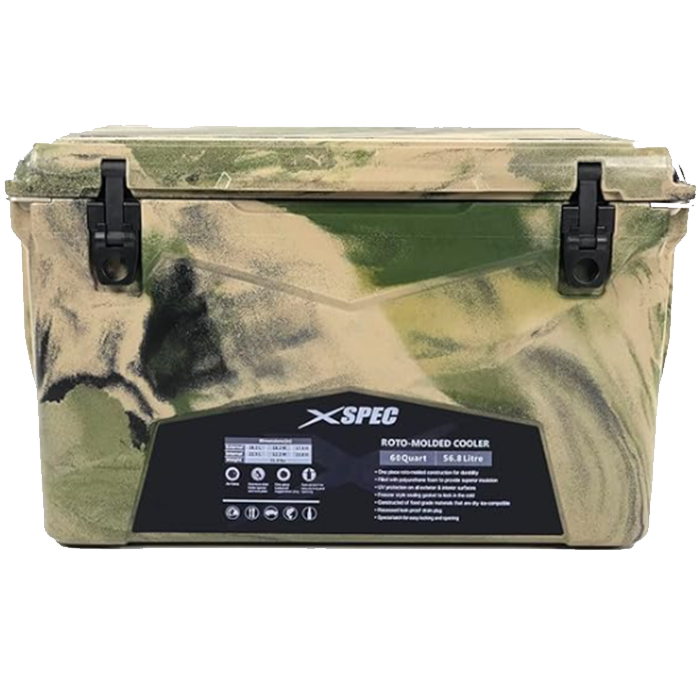
XSpec 60 QT
Most Durable and Insulated
CleverHiker Rating: 4.7/5.0
Price: $220
Empty Weight: 31 lb. 1 oz.
Volume: 57 qt.
Sizes: No alternate sizes in this model
Pros
- Keeps ice for 9 days
- Rotomolded design – durable construction
- Excellent insulation
- Useful built-in features
Cons
- Heavier than other options
- Limited size and color choices
- Not certified bear resistant
Though it doesn’t have the brand recognition of YETI or RTIC, the Xspec 60 QT modestly impresses with its tough durability, excellent insulating abilities, and affordable price.
The Xspec is rotomolded with three inches of insulation. It kept ice for over a week, finally taking nine days for the ice to completely disappear. With its freezer-grade gasket, which creates a tight seal between the cooler body and lid, the internal temperature remained below 40 degrees Fahrenheit for 11 days and took 13 days to reach 50 degrees Fahrenheit.
Though Xspec doesn’t offer the wide range of accessories or color options that other brands do, the cooler is made with quality materials and designed to meet user needs. It has a built-in bottle opener that also functions as a lock plate for extra security. There’s a compass pressed into its rim and a ruler engraved on the top of the lid, which has a textured surface that can also be used as a cutting board.
Made with UV-protected, food-safe LLDPE (a type of plastic), the Xspec is resistant to punctures and damage. Its single-piece rotomolded design is seamless, enhancing its structural strength and ability to handle rough conditions.
The cooler has a 90-can capacity, and its compact rectangular design can fit an upright bottle of wine, making it suitable for a multi-day trip in both size and insulation. However, when fully loaded, we found it very difficult to carry alone and preferred help from a second person. The Xspec does offer carry options—featuring built-in handles on the cooler’s body as well as heavy-duty nylon handles with durable rubber grips, which make it easier to manage the weight.
The Xspec 60 QT, with its quality design and reliable temperature control, is built to handle your toughest adventures, even those lasting several days. It’s a high-performance cooler at an amazingly low price, designed to withstand rough use and last for years.
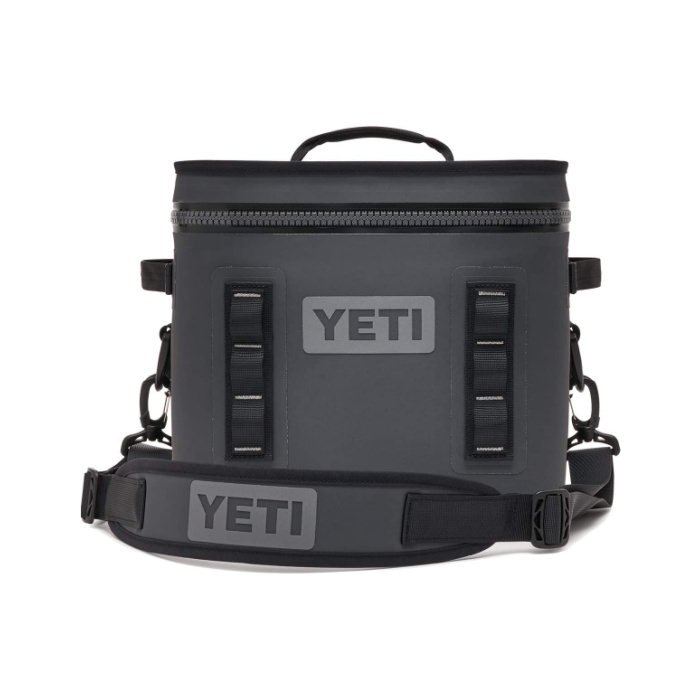
YETI Hopper Flip 12
Standout Soft Cooler
CleverHiker Rating: 4.5/5.0
Price: $250
Empty Weight: 3 lb.
Volume: 12 qt.
Sizes: 8, 12, and 18 qt.
Pros
- Waterproof and durable
- Portable
- Comes in variety of color choices
Cons
- Expensive for the size
- Zipper tricky to use
The YETI Hopper Flip 12 combines practical and attractive design, rugged durability, and portability — all in a soft shell cooler ready for your grab-and-go adventures.
Although soft coolers are typically designed for personal use rather than multi-day trips, the 24-can capacity of the Flip provides enough space to serve a small group or keep a modest selection of perishable items cold. Even when filled with ice, there was plenty of room for all the food and drinks needed for an all-day outing.
The Hopper features closed-cell foam insulation, and testing showed that it took just under four days for the ice to completely melt and to reach 40 and 50 degrees Fahrenheit. The foam insulation effectively retains cold for several days while also not adding excessive thickness that reduces the interior volume of the cooler.
The Hopper’s design is eye-catching, and each part of its construction ensures it can withstand tough outdoor conditions for years. All straps and carry points are secured with double stitching, strengthening them against wear and tear. The cooler’s exterior fabric is puncture-resistant and UV-resistant, with both interior and exterior materials treated to resist mildew. The zipper on the Flip is somewhat difficult to use—it takes two hands to open and close—but it is waterproof and prevents leaks. YETI also provides lubricant to help with zipper operation.
Already lightweight, the Flip is incredibly portable, even by soft cooler standards. YETI includes various carry options to enhance comfort and portability: a top handle sewn into the lid, side handles for handheld carrying, and a removable strap for slinging the cooler over the shoulder. The strap is generously padded, making it comfortable to carry even over longer distances.
The Flip is expensive for a soft shell cooler. However, it combines good insulation with high-quality design. Built for durability and outdoor use, the Hopper Flip is a smart investment in a cooler you can take almost anywhere.
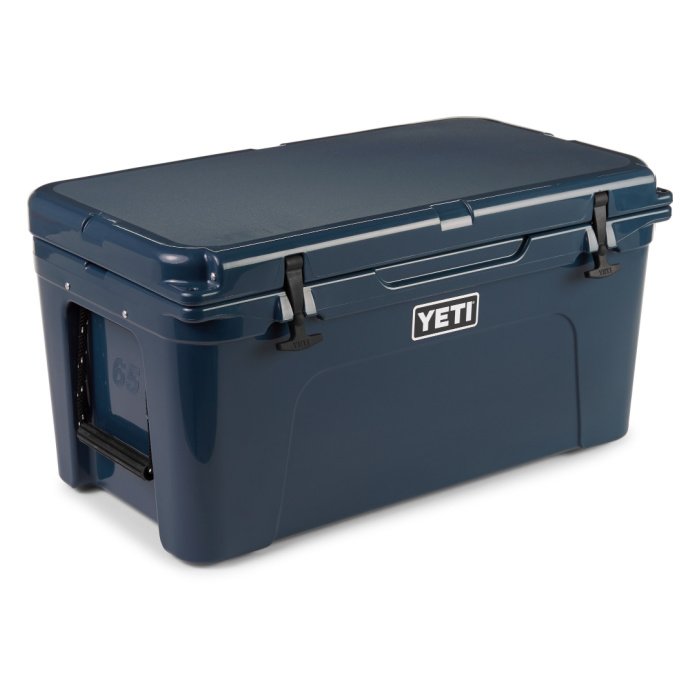
YETI Tundra 65
Top Pick for Longer Trips
CleverHiker Rating: 4.5/5.0
Price: $375
Empty Weight: 30 lb. 5 oz.
Volume: 56 qt.
Sizes: 35, 45, 65, 75, 105, 110, 125, 1160, 210, 250, and 350 qt.
Pros
- Durable design
- Rotomolded insulation retains ice for 9 days
- Certified bear resistant
Cons
- Awkward to carry solo
- Heavy
- Less interior space due to insulation
Whether you’re packing the car for a road trip or gearing up for a large group outing, the YETI Tundra 65 offers enough space to store all your food and drinks, along with top-tier insulation to keep them cold for over a week.
In our testing, we found that the Tundra kept ice for 9 days, took 11 days to reach 40 degrees Fahrenheit, and 13 days to reach 50 degrees, making it one of the top performers in temperature retention. The cooler features a rotomolded design with 2 inches of insulation and a freezer-style gasket around the lid to trap in the cold and ensure a tight seal that prevents leaks.
Its single-piece construction eliminates seams and enhances its rugged design, which is built to withstand the harshest conditions. It’s the only cooler on our list certified bear resistant by the IGBC—Interagency Grizzly Bear Committee—when used with an appropriate padlock.
The Tundra has a 77-quart capacity, and YETI offers the model in nearly a dozen different sizes. The cooler is marketed as 65 quarts, but we found its actual volume to be closer to 56 quarts, with a thick layer of insulation reducing some of its internal storage space. Still, as one of the largest coolers reviewed, the Tundra is more than capable of holding drinks and perishables for extended trips.
Like many of their products, YETI offers a range of accessories designed for the Tundra, including dividers, bear-proof locks, a tie-down kit, and seat cushions. Besides these add-ons, the Tundra features several built-in features that enhance its ease of use. Non-slip feet on the bottom of the cooler prevent it from sliding—especially helpful in a moving vehicle—and it has both incut handles on its sides and heavy-duty woven handles with sturdy hand grips for easy and comfortable carrying.
The size and weight of the Tundra make it less portable than other tested coolers. We found it heavy to carry alone, and its longer length made it somewhat awkward to transport by oneself. Although less convenient for solo carrying, when high-volume storage and long-lasting insulation are essential, the YETI Tundra 65 is among the best options and is well suited for large groups and longer trips.
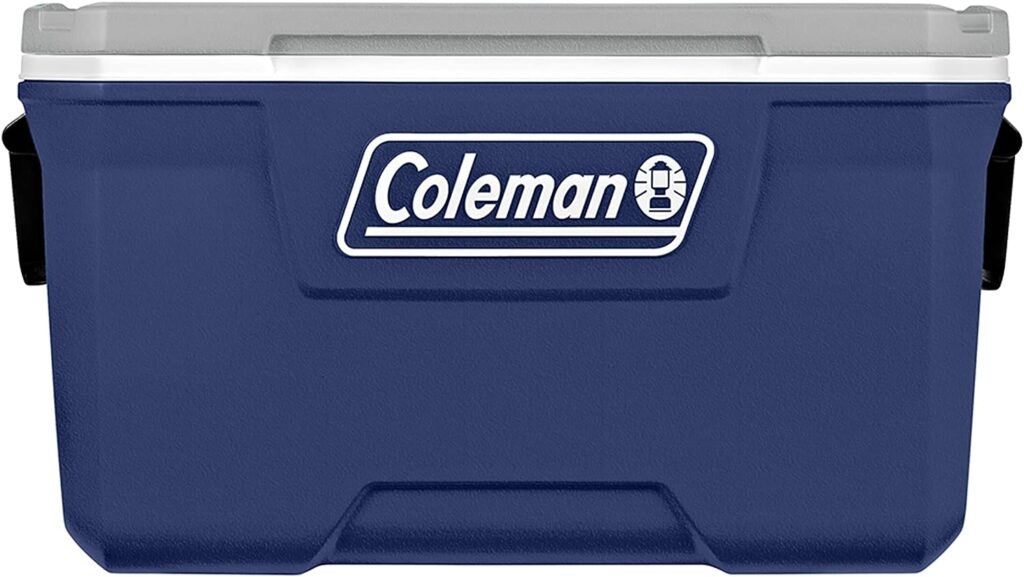
Coleman 316 Series 70 QT
Biggest Bang for Your Buck
CleverHiker Rating: 4.5/5.0
Price: $85
Empty Weight: 11 lb. 6 oz.
Volume: 70 qt.
Sizes: 52, 70, 120, and 150 qt.
Pros
- Affordable
- Lightweight
- Ample interior space
Cons
- No latches to keep lid closed
- Not as durable as other options
Coleman has been a trusted brand for both affordability and reliability, and the Coleman 316 Series 70 QT is no exception. With 70 quarts, it is not only the largest cooler on our list in terms of volume but also the most affordable. Capable of holding up to 110 cans, its large size makes it ideal for big backyard barbecues or other gatherings.
The size of the cooler provides plenty of space for food and beverages to accommodate a large group and the open rectangular shape makes it easy to find whatever you need inside. Though it’s one of the bigger coolers we reviewed, it’s also significantly lighter than comparable models. We found the longer length made the cooler somewhat awkward to carry on our own, but the light weight was incredibly easy to handle solo.
The 316 Series is made from blow-molded plastic, a type of insulation that isn’t as effective as rotomolded or injection-molded methods. However, the Coleman performed well — it took six days for ice inside the cooler to fully melt, eight days to reach 40 degrees Fahrenheit, and 10 days to finally hit 50 degrees Fahrenheit. Even without top-tier insulation, the Coleman impressed us with its ability to keep things cold for days on end.
The Coleman lid features built-in cupholders—a useful feature when you’re short on a picnic table—but we found its lack of latches and the cooler’s plastic construction weaken its design. Without latches, there’s no way to secure the lid, and we noticed leaks from the gap between the lid and the cooler’s body. The plastic build is also less durable and more susceptible to damage, which shortens its lifespan compared to other options. For trips where a cooler might be tossed in and out of a car or dragged around, a more sturdy, tight-sealing cooler is a better choice.
Though not the burliest cooler on our list, the Coleman 316 Series 70 QT is ideal for when you have a big group or lots of things to keep cold. With its large capacity and surprisingly lightweight design, it offers great value at a low price.
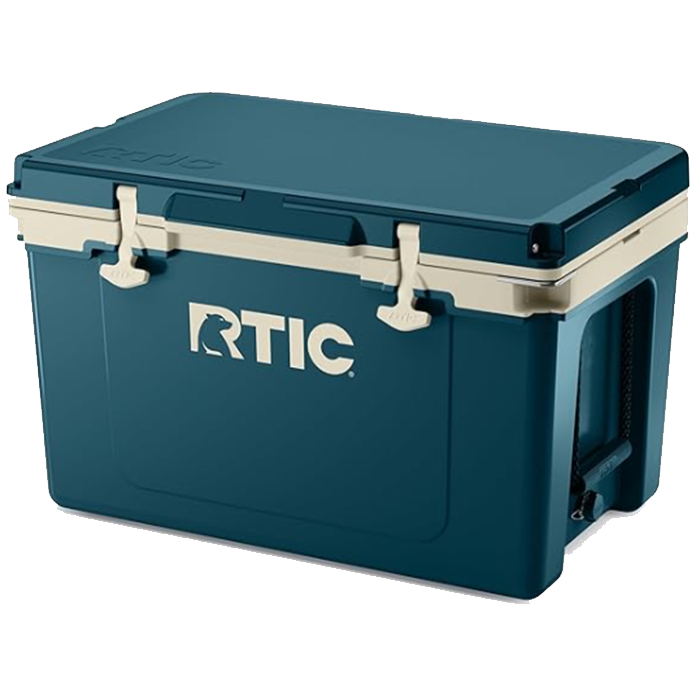
RTIC Ultralight 52
Lightest Weight High Volume Cooler
CleverHiker Rating: 4.2/5.0
Price: $230
Empty Weight: 21 lb.
Volume: 49 qt.
Sizes: 22, 32, 52 qt. / 52 and 72 qt. with wheels
Pros
- Very lightweight for size
- Affordable
- Durable design
Cons
- Not rotomolded
- Doesn’t retain ice as long as others
A large cooler can be a beast to haul from your car to the campsite, but the lightweight design of the RTIC Ultralight 52 makes it easy to carry alone without sacrificing space for everything you need to keep cool.
The RTIC features an injection-molded insulation style, which helps reduce its weight, especially when compared to rotomolded coolers. When stacked against other high-volume coolers, we found the lighter frame and boxier shape of the Ultralight 52 easy to carry, even when fully packed. In addition to side handles molded into the cooler’s body, RTIC offers sturdy nylon rope handles with rubber hand grips, providing a more flexible and comfortable carrying option.
Able to hold up to 76 cans and upright 2-liter bottles, the RTIC Ultralight offers enough capacity for a long weekend trip or a midsize group. The cooler features 3 inches of closed-cell foam insulation and an o-ring gasket that seals in cold air. In our testing, we found the Ultralight 52 retained ice for seven days, took eight days to reach 40 degrees Fahrenheit, and ten days to reach 50 degrees.
Although the RTIC didn’t keep cold temperatures as long as similar rotomolded options, it still performed well, and its combination of ample storage and light weight gives it an extra advantage.
The RTIC is not only lightweight to carry but also easier on the wallet, with a lower price tag than other high-volume coolers we reviewed. When you need to keep a lot cool but want something that won’t strain your back, the RTIC Ultralight 52 offers ample storage space and high-performance insulation to meet your needs without sacrificing portability.
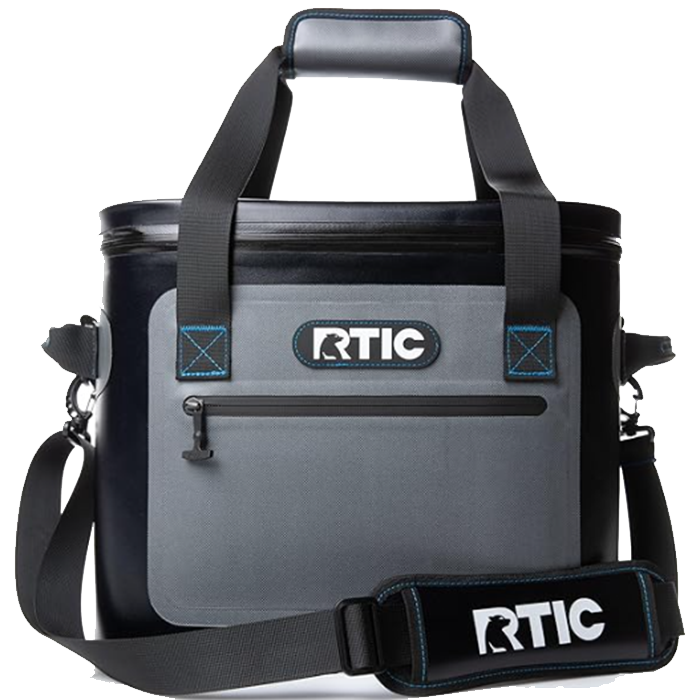
RTIC Soft Pack Cooler
Best Waterproof Soft Cooler
CleverHiker Rating: 4.1/5.0
Price: $130
Empty Weight: 4 lb.
Volume: 14 qt. (30 can)
Sizes: Available in 12, 20, 30, and 40 can size options
Pros
- Durable design
- Waterproof
- Floats
- Portable
Cons
- Zipper is somewhat hard to use
- Thickness of insulation loses some interior capacity
Whether you’re floating a river, hanging out at the beach, or going for a forest picnic, the RTIC Soft Pack Cooler is light and portable, offering a sturdy, waterproof design with excellent temperature retention.
The RTIC is a soft-shell cooler, but both its sturdy coated exterior and inner lining are resistant to tears and punctures. It also has a heavy-duty waterproof zipper that helps with cold retention and keeps water out, while also preventing leaks. Although the zipper provides an effective waterproof seal, we found it somewhat stiff and difficult to unzip, even after multiple uses. However, RTIC does include lubricant that makes the zipper somewhat easier to operate.
With 1.5 inches of closed-cell foam insulation, the Soft Pack is well designed to keep items cold for a long weekend. In our testing, it took four days for ice to completely melt inside the Soft Pack and reach an internal temperature of 40 degrees Fahrenheit, while it took 5 days to reach 50 degrees.
The thickness of the foam insulation slightly reduces the interior capacity of the cooler, but the RTIC still holds 30 cans and is large enough for an all-day outing or the cold essentials for a weekend trip.
Unlike other soft shell coolers we reviewed, the Soft Pack floats, making it perfect for water use. With its buoyancy, rugged durability, and cold retention, the RTIC Soft Pack is a portable option that can handle all your outdoor needs — on or off the water.
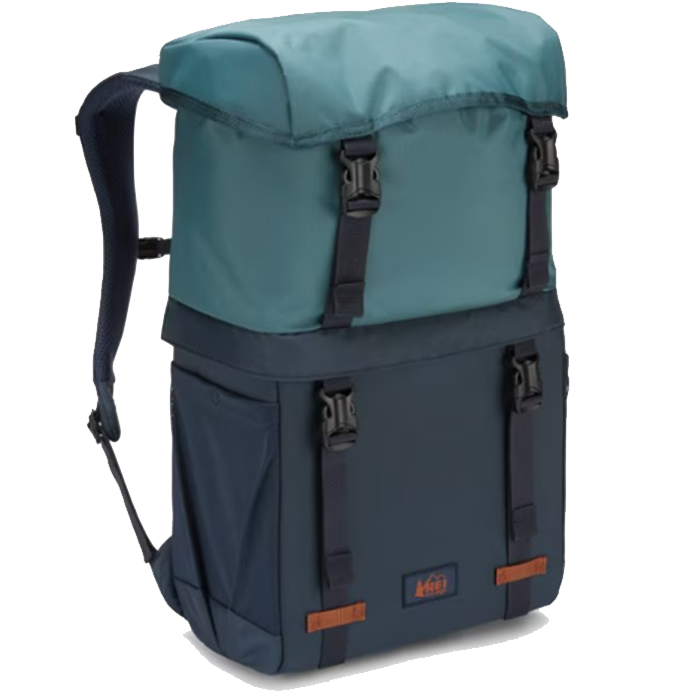
REI Cool Trail Split Pack Cooler
Most Portable Soft Cooler
CleverHiker Rating: 4.0/5.0
Price: $85
Empty Weight: 2 lb. 8 oz.
Volume: 33.2qt (total), 19qt (cooler portion)
Sizes: No alternate sizes available
Pros
- Extremely portable and lightweight
- Offers additional storage space for gear
- Removable cooler insert
Cons
- Smaller cooler capacity with split design
- Less effective insulation
For days when you want to go off the beaten trail, but still need to keep things cold, the REI Cool Trail Split Pack Cooler combines a rucksack with a cooler to create an extremely portable backpack-style option.
As its name indicates, the Split Pack is divided into two parts: the bottom is a soft-shell cooler, and the top offers space for other necessities that don’t need to be kept cold. With a simple pull on the zipper, the middle of the pack opens up to reveal the removable cooler insert. The cooler section of the Split Pack only holds 12 cans, making it the smallest volume cooler we reviewed, but the storage space in the top half is a feature unique to the Split Pack.
While the smaller capacity of the cooler is ideal for 1-2 people, we found the Split Pack to be the perfect choice for bringing our lunch to work or for carrying a cold drink while hiking. Designed with heavily padded, adjustable straps, the pack is comfortable to carry, even over longer distances. We used the Split Pack during our bike commutes and appreciated being able to keep a meal cool while also having space for a spare sweater, book, snacks, and wallet in the top compartment.
The cooler insert of the Split Pack is made from a thin, flexible foam, which helps keep its overall weight low. The thin insulation means it doesn’t hold ice or cold temperatures for very long, but it still took the cooler three days for the ice to completely melt and reach a temperature of 40 degrees.
While its insulating abilities and smaller capacity might not match other coolers on this list, the dual function of the Split Pack as both cooler and pack gives it an advantage and offers unbeatable portability. It’s a great personal-sized choice that’s perfect for day hikes or situations where carrying a cooler isn’t practical.
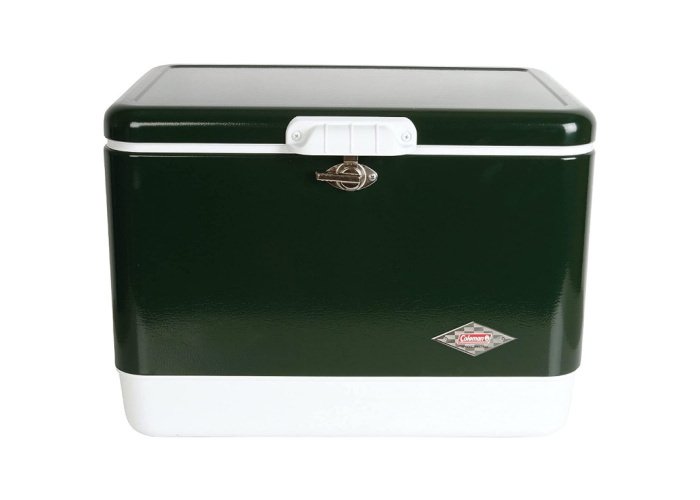
Coleman Steel Belted Cooler
Stylish and Budget-Friendly
CleverHiker Rating: 3.8/5.0
Price: $200
Empty Weight: 17 lb.
Volume: 54 qt.
Sizes: No alternate sizes available
Pros
- Lightweight
- Ample interior space
- Attractive vintage design
Cons
- Less effective insulation
- Metal exterior gets hot in the sun
With its retro metal exterior and accents, the Coleman Steel-Belted Cooler features a stylish vintage design that keeps items cold and while still being affordable. Rust-free stainless steel covers the outside of the Coleman, providing a sleek look, protecting its plastic interior, and standing up to falls with only minor dings.
With an 85-quart capacity, the Coleman offers plenty of space, making it ideal for a small group or weekend trip. The slim profile of the insulation allows the cooler to maximize storage while still keeping items cold. It retained ice for nearly five days, with internal temperatures reaching 40 degrees Fahrenheit in five days and taking six days to hit 50 degrees Fahrenheit.
Although a higher-capacity cooler, we found that Coleman’s compact design made it easier to carry on our own. The thin metal handles with minimal plastic padding were uncomfortable to use over time, but the cooler’s light weight alleviates this issue.
The metal latch adds to the vintage charm, but we found we could still open the lid even with the latch closed. When tipping the cooler, water would leak out through the seam between the lid and the body, indicating this seal isn’t completely tight. However, the cooler still works well at keeping items cool.
The retro design of the Coleman Steel Belted Cooler offers a unique look compared to other coolers on the market. While vintage metal details enhance the cooler’s aesthetic appeal, they also add to its durability.
To top it off, the Coleman is an affordable option, especially for a high-volume choice. With its affordability, eye-catching design, and user-friendly features, it’s a great pick for events where you need to keep things cold and want your style to stand out.
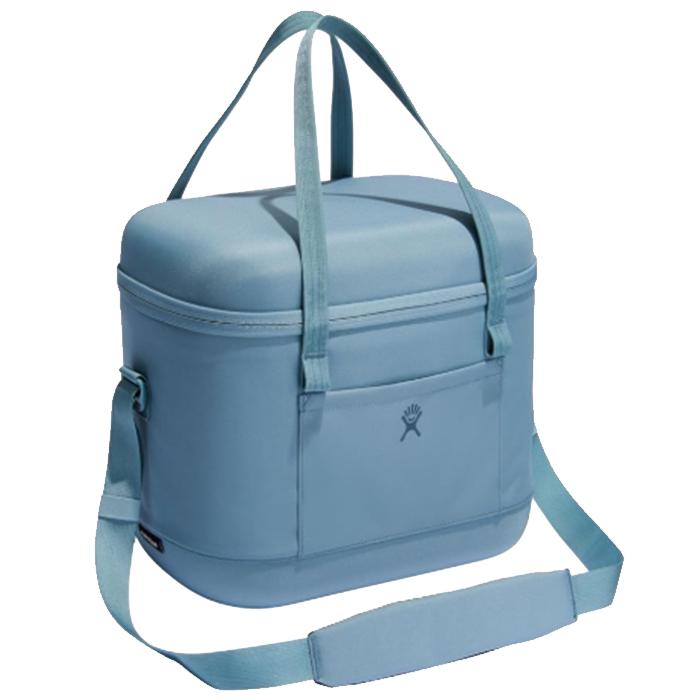
HydroFlask Carry Out 20L
Most Affordable Soft Cooler
CleverHiker Rating: 3.6/5.0
Price: $90
Empty Weight: 2 lb. 12 oz.
Volume: 21 qt.
Sizes: 12 and 20L
Pros
- Affordable
- Stylish design
- Lightweight
Cons
- Not waterproof
- Less burly than similar options
- Insulation less effective
The HydroFlask Carry Out 20L is a stylish and budget-friendly choice, perfect for casual outings. Available in various attractive colors, the design features sleek rounded edges and a 38-can capacity, which is more spacious than many other soft-shell coolers reviewed.
The exterior of the Carry Out has a premium look thanks to its fabric material. However, it is water resistant but not completely waterproof, and HydroFlask advises keeping the cooler away from sharp objects—making it more suitable for mild outdoor environments.
The foam insulation is much thinner than that of other coolers, which allows the Carry Out to stay lightweight and highly portable while maximizing interior space. The cooler kept ice for two days, and it took four days to reach internal temperatures of 40 and 50 degrees Fahrenheit. Temperature control is more limited with the HydroFlask compared to other tested options, making it a better choice for trips where items don’t need to stay cool for as long.
The HydroFlask has built-in carry handles and comes with a detachable shoulder strap, offering convenient options for moving the cooler between locations. The zipper that keeps the lid closed is easy to operate, especially compared to the tough waterproof zippers on YETI and RTIC’s soft shell coolers, but it can leak water and doesn’t help keep in cold temperatures.
Ultimately, the HydroFlask Carry Out is an excellent option for casual outings and day trips. With its attractive design and portability, the Carry Out is a roomy soft-shell cooler with a sleek look that comes at a very affordable price.
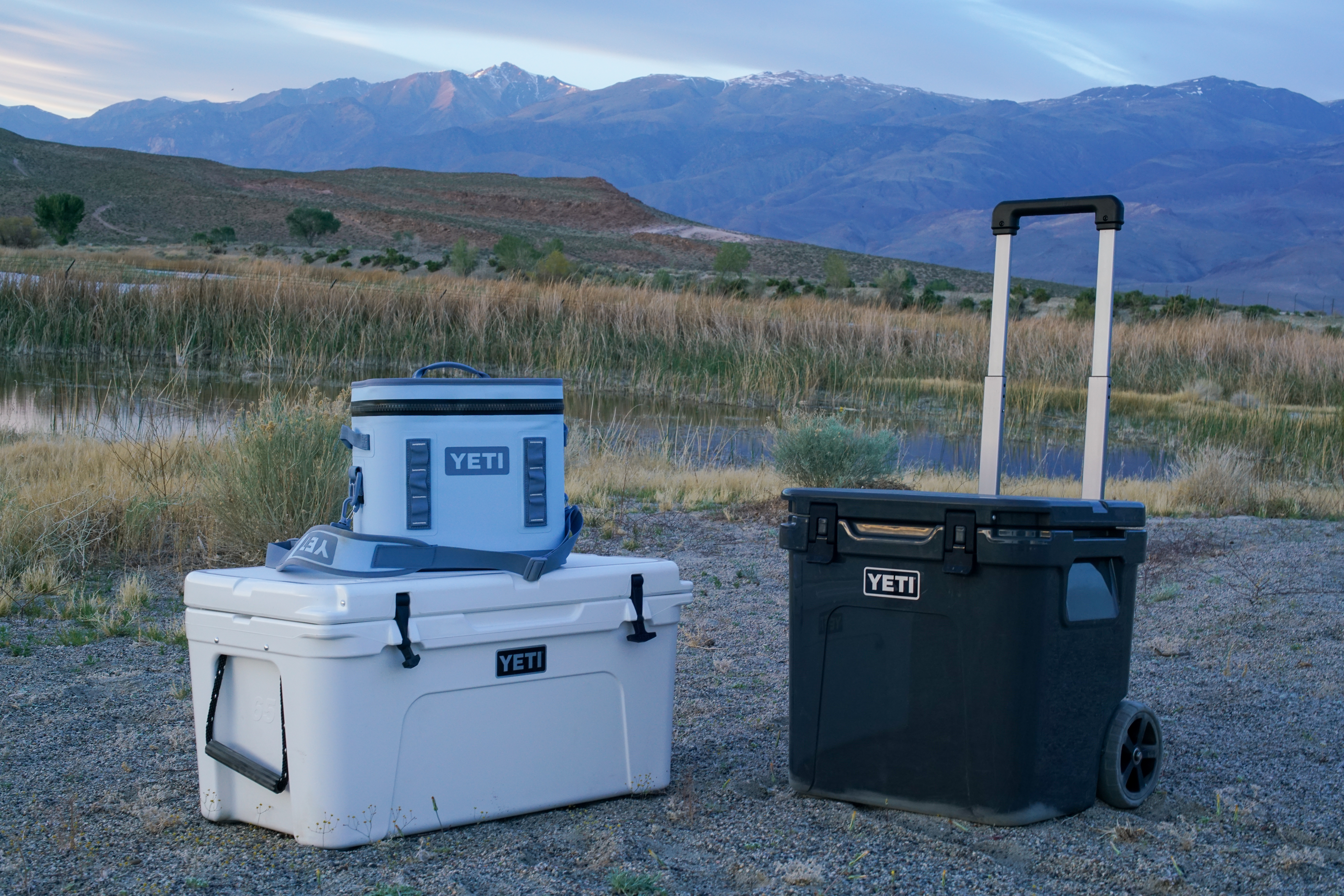
Product Comparison Table
| oSort | Product | Price | Empty Weight | Volume | Sizes | Insulation | Durability | Portability/Ergonomics | Volume Rating | Features | 0 |
YETI Roadie 48 View at REI View at Amazon |
$425 | 28 lb. 5 oz. | 45 qt. | 15, 24, 32, 48, 60 qt. | 4.8 | 4.8 | 4.9 | 4.5 | 4.8 | 1 |
XSpec 60 QT View at Amazon |
$220 | 31 lb. 1 oz. | 57 qt. | No alternate sizes in this model | 4.9 | 4.6 | 4.0 | 4.7 | 4.5 | 2 |
YETI Hopper Flip 12 View at REI View at Amazon |
$250 | 3 lb. | 12 qt. | 8, 12, and 18 qt. | 4.3 | 4.7 | 4.6 | 4.1 | 4.1 | 3 |
YETI Tundra 65 View at REI View at Amazon |
$375 | 30 lb. 5 oz. | 56 qt. | 35, 45, 65, 75, 105, 110, 125, 1160, 210, 250, and 350 qt. | 4.8 | 4.9 | 4.1 | 4.1 | 4.7 | 4 |
Coleman 316 Series 70 QT View at Amazon View at Walmart |
$85 | 11 lb. 6 oz. | 70 qt. | 52, 70, 120, and 150 qt. | 4.6 | 3.9 | 4.3 | 4.9 | 3.8 | 5 |
RTIC Ultralight 52 View at Amazon View at Walmart |
$230 | 21 lb. | 49 qt. | 22, 32, 52 qt. / 52 and 72 qt. with wheels | 4.7 | 4.6 | 4.7 | 4.0 | 4.4 | 6 |
RTIC Soft Pack Cooler View at Amazon |
$130 | 4 lb. | 14 qt. (30 can) | Available in 12, 20, 30, and 40 can size options | 4.4 | 4.4 | 4.4 | 4.3 | 4.0 | 7 |
REI Cool Trail Split Pack Cooler View at REI |
$85 | 2 lb. 8 oz. | 33.2qt (total), 19qt (cooler portion) | No alternate sizes available | 3.7 | 4.2 | 4.5 | 3.6 | 3.5 | 8 |
Coleman Steel Belted Cooler View at REI View at Amazon |
$200 | 17 lb. | 54 qt. | No alternate sizes available | 3.9 | 3.9 | 3.8 | 4.5 | 3.7 | 9 |
HydroFlask Carry Out 20L View at Amazon View at Hydro Flask |
$90 | 2 lb. 12 oz. | 21 qt. | 12 and 20L | 3.6 | 3.7 | 4.1 | 4.4 | 3.6 |
|---|
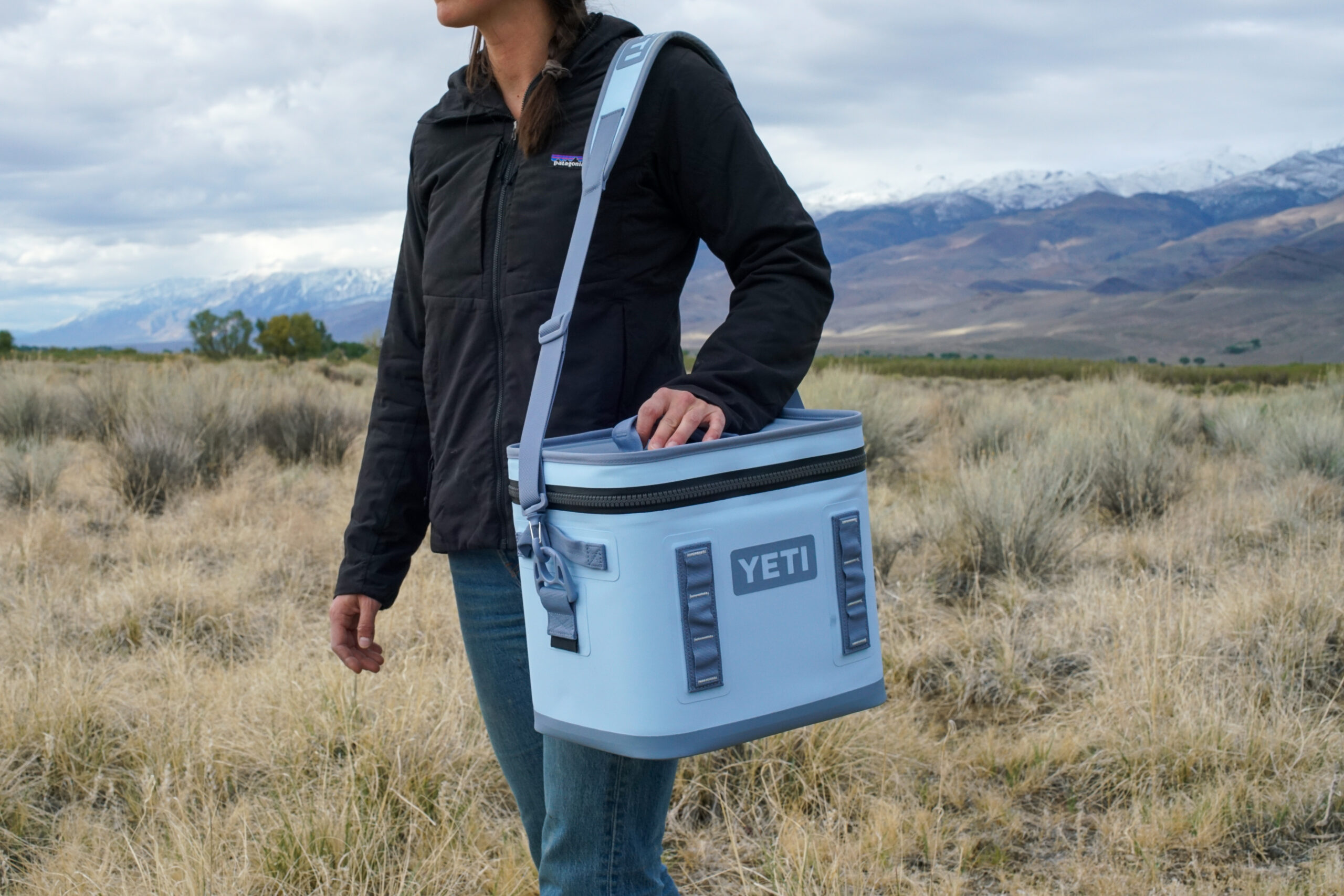
How We Test
We assessed these coolers based on five criteria: insulation, durability, volume, ergonomics/portability, and features—believing these elements to be hallmarks of a high-quality cooler. To evaluate these aspects, we spent a few months testing them by chilling food and drinks for single-day outings and monitoring their ability to keep items cold over multiple days.
We tested them across various environments in the high desert landscape of eastern California: from the high elevation rocky foothills of the Sierra Nevada, along the marshy banks of the Owens River, to navigating everything from paved roads to washboard roads inside a van.
INSULATION
When it comes to coolers, insulation is probably the most important factor. How well it can keep things cold and how long it takes before that bag of ice turns into a pool of water are key aspects in evaluating the insulating ability of a cooler.
We filled each cooler with ice, perishable food items, and canned drinks, then rotated them between outdoor locations exposed to full sun and the interior of a parked car. For over a week, we monitored ice retention—how long it took for ice cubes to melt—and used a thermometer to measure the internal temperature of each cooler, noting when they reached 40 degrees Fahrenheit (the safe storage limit) and 50 degrees Fahrenheit (the ideal maximum temperature for chilled beer).
We also examined the insulation type used with each cooler and its thickness. Common insulation methods include rotomolding, injection molding, and closed-cell foam insulation.
Rotomolding, or rotational molding, involves spinning hot plastic inside a mold to form a seamless shell that makes up the cooler’s structure. This shell is then filled with inches of foam. The one-piece design of rotomolded coolers removes seams that could crack or split and enhances their strength. However, this type of cooler is often heavier because of the thick layer of insulation.
Injection molding is similar to rotomolding; however, instead of making a single hollow piece, two parts are produced from molds, fused together, and filled with insulating foam. Fusing two separate parts creates seams and increases the risk of cracks and splitting. Injection-molded coolers use less plastic, making them lighter, but their insulating performance is often not as good as rotomolded options.
Closed cell foam insulation is common in soft shell coolers. Trapped air bubbles within the foam prevent air from passing through, ensuring better insulation. While this insulation method doesn’t last as long as other types, the foam is usually lighter and more flexible.
Each insulation type comes with its own pros and cons regarding effectiveness and weight, and we included these factors in the coolers’ performance in this category.
DURABILITY
To best evaluate the durability of a cooler, we analyzed its construction, focusing on whether it is made with durable materials, the quality of its build—especially components like hinges, latches, and handles—and its ability to handle rough outdoor use.
We dragged, dropped, and applied pressure to handles and lids across various terrains to see if the coolers sustained scratches, punctures, or damage and to estimate their overall lifespan.
VOLUME
Volume measures how much a cooler can hold. This guide covers both large coolers suited for multi-day trips and smaller ones for single-day use. We tested different combinations of food, drinks, and ice in each cooler to see how many days’ worth of supplies they could realistically hold and whether personal-sized coolers were truly enough for an entire day outdoors.
A primary function of coolers is to keep beverages cold, so we also filled each cooler with as many canned drinks as possible to evaluate capacity differences. Additionally, we examined how insulation type and thickness affected the cooler’s interior storage space.
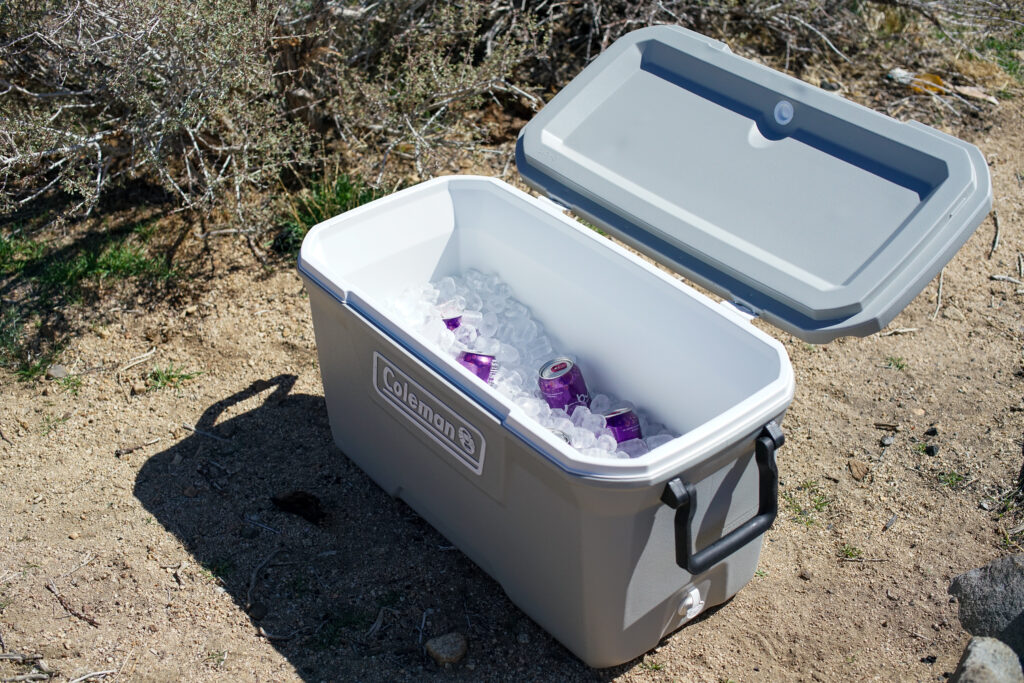
ERGONOMICS & PORTABILITY
Ergonomics and portability focus on how easily a cooler can be transported and evaluate the functionality of its design. Our cooler selections include backpack and shoulder straps, wheels, and handles, which we tested for comfort and ability to carry across different terrains and distances.
We also examined how weight—both of the cooler itself and its distribution inside—and its shape affected our ability to carry it easily, especially as a single person.
We tested the latch and lid design, as well as whether the cooler featured drain holes, for leakiness, ease of use, and temperature retention to better understand the overall functionality of the cooler.
FEATURES
Coolers can be an investment, and choosing one tailored to your specific needs and usage is the final step in determining which option will work best. The features metric examines how a cooler can be customized or fit a particular niche.
We examined the accessories—such as baskets, dividers, and cup holders—manufacturers offered and visited their websites to see if other color or capacity options were available. We also noted additional design features—including built-in bottle openers, tie-down slots for mounting, and locking systems—and checked whether a cooler was certified bear resistant.
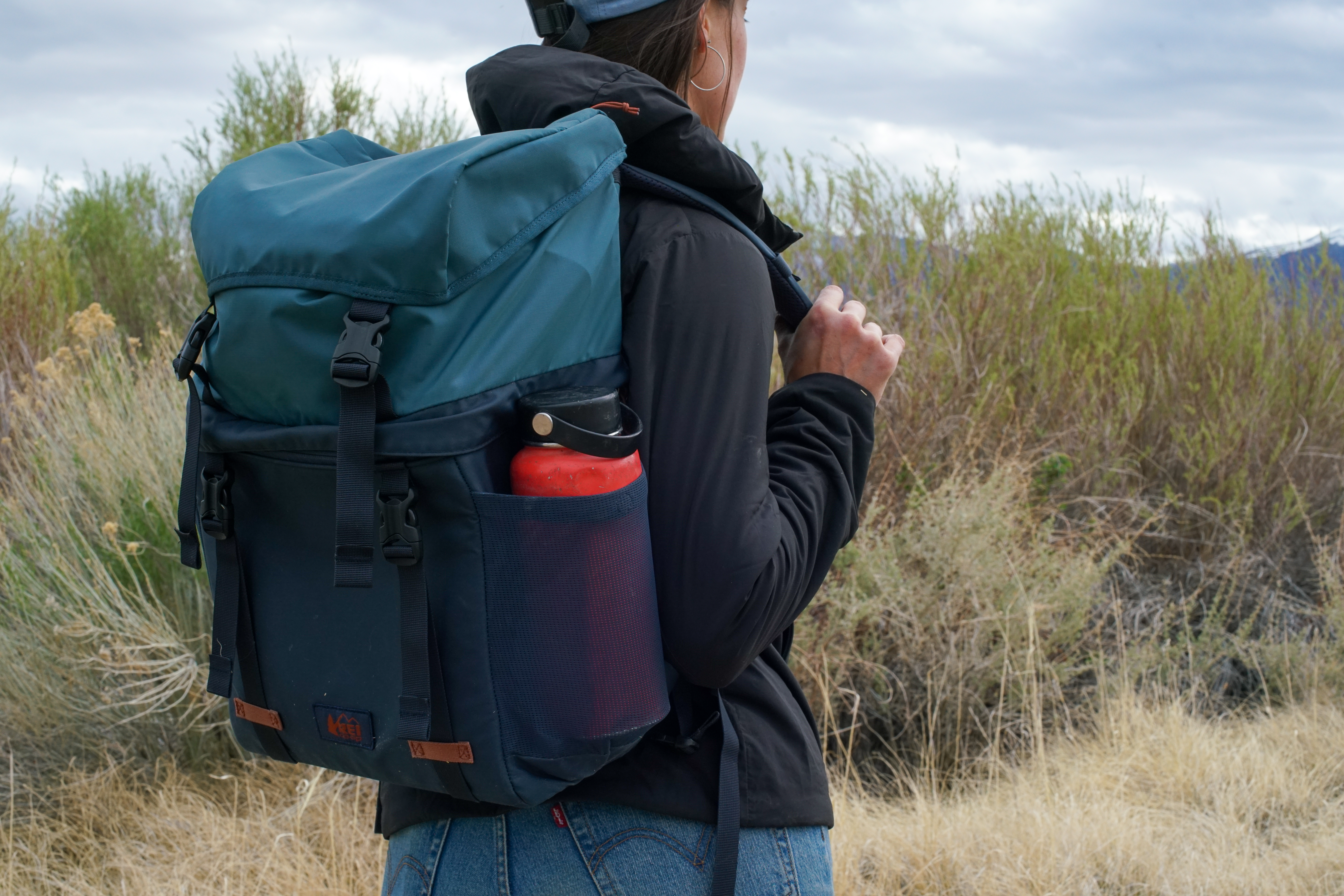
Why Trust Cleverhiker
At CleverHiker, we researched 35 different coolers on the market to narrow down our list to the top ten highest performers. As a former van-dweller who lived in her RAM ProMaster for a year across the western United States, gear analyst Marion Tucker understands the importance of having a way to keep things cold while on the road or when access to a fridge isn’t an option.
For this guide, Marion tested these coolers side by side in the field, which involved several days of monitoring ice retention and temperature, taking the coolers into the foothills of the Sierra Nevada to observe how well they functioned, and playing Tetris with dozens of cans, perishable foods, and bags of ice to see exactly what each cooler could hold.
As someone with experience living on the road and managing food cold storage, as well as enjoying a cold beer after a hot day outside, she is well equipped to evaluate what makes a cooler top-notch.
Analysis & Results
We rank coolers based on several metrics: insulation, durability, volume, ergonomics, portability, and features. Our results below highlight which models excelled in each category.
VALUE
Coolers can be costly, and it’s important to understand how price influences your choice. We considered not only the monetary expense but also the quality of design and durability when assessing a cooler’s overall value.
The upfront cost of the Yeti Roadie 48 might cause a double take, but although its price tag is the highest among the coolers we tested, we firmly believe it will last for years. Especially if you use coolers for road trips or long-term cold storage, the Roadie’s excellent insulation and unmatched wheeled portability make it a versatile cooler for various environments. Made from high-quality materials, it is sturdy and backed by YETI’s top-tier warranty. While its initial cost is steep, the Roadie’s durability means you won’t need to buy another cooler for many years.
On the opposite end, the Coleman 316 Series 70QT is the most affordable cooler on our list. Although it comes with the lowest price, the Coleman still impresses by keeping ice for over a week and offering enough space to supply a party with cold drinks. Lacking latches to seal it tightly and having some structural flaws, the Coleman isn’t ideal for rough outdoor use or intensive travel. Still, it’s a budget-friendly choice perfect for big gatherings and day trips where you need a large-volume cooler, making the Coleman an inexpensive solution for these special occasions.
Although it doesn’t have the brand recognition of YETI, the Xspec 60QT features top-quality rotomolded insulation, a spacious interior, and an incredibly affordable price that make it an all-around excellent cooler. The Xspec is designed to handle the toughest conditions and is more than capable in both its volume and temperature control to manage multi-day trips and larger groups. When you need to rely on your cooler, the Xspec is there to support you and withstand rougher use, all without putting too much strain on your wallet.
INSULATION
Rotomolding is widely regarded as the gold standard of insulation styles, offering better temperature control and longer ice retention. The XSpec 60QT and the YETI Tundra 65 meet this expectation with their excellent cold preservation.
Both coolers feature several inches of insulation and freezer-style gaskets that create an extra seal to maintain cool temperatures. They were almost identical in how long it took for the ice to completely melt (nine days) and reach internal temperatures of 40 degrees Fahrenheit (11 days) and 50 degrees (13 days).
With over a week and a half of cold storage, the XSpec and Tundra are perfect for longer trips. Especially when transporting perishable items, these coolers provide reliable storage to keep everything at food-safe temperatures.
The Yeti Roadie 48 is not rotomolded, but it proves to be one of the best insulators available, outperforming the XSpec and Tundra in ice retention. It took 10 days for ice to melt in the Roadie and 11 and 12 days to reach 40 and 50 degrees Fahrenheit.
A gasket and locking latches, along with the quality of the insulation itself, allow the Roadie to preserve temperatures for days effectively. With its wheels and smaller volume, it’s a portable alternative to the XSpec and Tundra that can provide superior cold storage for multi-day trips.
Overall, when it comes to insulation, we found that design elements like a lid gasket and tightly-sealing latches help maintain cold temperatures by keeping the coolers firmly closed. Coolers without latches or consumer-grade zippers allowed the cold to escape more easily. It’s frustrating to constantly refill a cooler with ice, and a well-insulated option will enable you to stay off the grid longer while also saving you money by avoiding repeated purchases of ice
DURABILITY
The fabrication technique of rotomolded design allows this type of cooler to be made as a single piece, giving it an advantage in durability. Both the XSpec 60QT and YETI Tundra 65 are rotomolded and feature strong, structurally sound construction without seams or weak points. Both coolers are made with UV-resistant polyethylene and include other high-quality materials in their handles and latches.
The Tundra has a slight advantage over the XSpec with its IGBC bear-resistant certification, but both coolers are equally durable and built to handle tough outdoor conditions. Each component of these coolers is designed to withstand rough use and rugged environments. The XSpec and Tundra are fully equipped for outdoor adventures and durable enough that they won’t need replacing for years.
Although not rotomolded, the YETI Roadie 48 is still made with a single-piece construction, giving it the same seamless design as the XSpec and Tundra and increasing its structural strength. Without seams that might crack or split, the Roadie is prepared to handle tough environments and outdoor use. This durability extends to other features like the wheels and periscope-style handle. The puncture-resistant wheels are made as solid pieces, allowing them to better navigate uneven terrain, including rocky trails and sand. The handle also performs well in challenging conditions; its design resists torque even when pulling a fully loaded cooler. Built with high-quality, durable materials, the Roadie is suited to withstand intense use and is built for long-lasting performance.
VERSATILITY
The GSI Outdoors Pinnacle Camper truly stands out as the most versatile cookset. It’s lightweight enough to carry on the trail, compact enough to fit in a backpack, and easy to stack, use, and clean. The Pinnacle is ideal for backpackers and campers alike. Although its nonstick coating is less durable than stainless steel sets, the convenience and light weight make up for it. Using soft utensils can help preserve the nonstick surface.
GSI scores another winner in the versatility category with the Bugaboo Ceramic Basecamp Cooker in large, again, in no small part because the set is light, nonstick, and boils water quickly. Unlike the Pinnacle, this set is specifically designed for cooking. Still, it can accommodate a variety of groups and family sizes, making it ideal for both shorter backpacking trips and longer camping excursions.
If you’re looking for versatility across the board, the Stanley Wildfare Core Full Serve Cookset, the Stanley Wildfare Core Frypan Cookset, and the GSI Outdoors Pinnacle Camper do the most things for the most scenarios. From multi-day hikes, shorter backpacking excursions (especially with multiple people to divvy stuff up between), and car camping, these sets have you covered. These sets all come with multiple options for the actual cooking – boilers, frypans, strainers, utensils, and flatware, and some have added extras like sippy cups and cutting boards. The only limit these sets place on what you can cook is their size, but they all handily feed a group of two to four and even five if you get creative or have littles mixed in.
Versatility within categories is also a consideration if you are looking for specific gear for a particular trip, such as a thru-hike, a two-week backpacking trip, an overnight hike, or a week-long desert or river adventure where you’ll set up base camp out of the back of a couple of cars. Within the three cooksets we tested for longer backpacking and thru-hiking, for example, small details such as whether the set has cups, whether there are any utensils included or even having too many accessories can all become deal-makers and dealbreakers.
The MSR Quick 2 Cookset excelled in this category due to thoughtful features, such as insulated mugs and a nonstick surface on its pot, which allowed for more meal options. However, someone aiming to maximize weight savings and minimize costs should consider the Stanley Wildfare Two Cup Cookset. Conversely, those less focused on minimalism might prefer the GSI Halulite Dualist, as it includes bowls and sporks, and promotes easy cleanup with its welded sink.For car camping, the Stanley Even Heat Camp Pro Cookset provides a variety of options, while the Lodge Cast Iron Combo Cookset handles all tasks with fewer parts but requires a bit more skill to use.
VOLUME
Layers of insulation can reduce a cooler’s internal storage space, and advertised capacities often don’t reflect a product’s actual volume. However, this isn’t the case with the Coleman Steel Belted Cooler. Its insulation is thinner than other options, but it focuses on maximizing storage space while still providing good temperature control. The Coleman’s 54-quart capacity falls just short of the 60-plus quart coolers we reviewed (although we found the real volume of these coolers to be in the high 50s), but it still holds more cans than some of those options. It maximizes storage while maintaining a compact profile and footprint, making it easy to carry while dedicating as much space as possible to keep your items cold.
The boxy design of the Yeti Roadie 48 differs from the longer rectangular frames of other coolers. However, its increased vertical shape makes it more suited for not only cans but bottles and taller items as well. In our testing, we managed to pack the Roadie with everything needed for an extended weekend trip, and the unique shape didn’t limit our packing options. Although it’s not the largest cooler we’ve reviewed, the Roadie proves to be practical for mid-size groups and short, multi-day trips, perfectly fitting the space as it’s not too big but still capable of holding all essentials plus some.
The Coleman 316 Series 70QT is the largest-volume cooler we tested. When you need to keep a lot cool, its 100-plus can capacity and 70-quart size are more than able to meet the demands of high-volume or large groups. The spacious interior of the cooler allows for a few days’ worth of food and drinks. Although the Coleman is best suited for more casual occasions, its spaciousness is unmatched when you require high-capacity storage.
PORTABILITY & ERGONOMICS
The YETI Roadie 48 stands out for its portable and ergonomic design. Unlike other coolers tested, the Roadie has puncture-resistant wheels built to handle terrain from sand to rocky paths. Its powerful wheels make it easy to take the cooler into different environments without straining your back when the destination is far. A periscoping handle allows you to pull the cooler on its wheels, and it also features built-in molded handles. It weighs several pounds less than similar-sized models, reducing the load when carrying it by hand. The cooler is highly portable and designed for ease of use, with non-stick feet, an accessible rear drain, and a textured lid that can double as a cutting board or seat—many features that enhance its functionality.
The only backpack-style cooler we reviewed, the REI Cool Trail Split Pack, is a cooler you can take even farther down the trail thanks to straps that secure it to your back. Even when fully loaded, the thickly padded straps remain comfortable and adjustable, allowing you to perfectly fit the pack to your body. With its backpack design, the Split Pack is ideal for bicycle commutes or miles of hiking. Its divided design is another helpful feature, offering space for both cold storage and everything else you need on a day out, saving you from having to carry an extra bag along with your cooler.
The YETI Hopper Flip 12 is lightweight and portable, offering various options for carrying it from one place to another. The Flip features a top handle, side handles, and a removable shoulder strap, all reinforced with double stitching at the attachment points to handle maximum strain. Whether you sling it over your shoulder or carry it in your hand, YETI provides multiple ways to carry it. When transporting the Hopper by vehicle, its small, compact shape makes it easy to fit into a fully loaded car trunk or toss on the floor of the passenger seat. It’s a grab-and-go cooler small enough and lightweight enough to take anywhere, with built-in options for comfortable carrying.
FEATURES
If you’re looking for a cooler you can accessorize and customize to meet your specific needs, YETI coolers, like the YETI Tundra 65 and YETI Roadie 48, are a clear choice. As one of the leading manufacturers of insulated products, YETI is a one-stop shop for outfitting yourself with a cooler and its essential accessories.
YETI offers their coolers in a wide range of colors, from neutral tones to vibrant shades. They also sell an assortment of accessories—such as dividers, baskets, and locking systems—designed specifically for their products. When you’re looking for an effective way to organize your cooler, YETI provides options that can separate items or keep more delicate things from coming into direct contact with the ice.
Along with these organizational features offered by YETI, the Tundra was also the only IGBC-certified cooler we tested. For those heading into more rugged environments and using their coolers in bear country, this is a key feature that sets the YETI apart from other options.
Across brands, many of the coolers we reviewed come in various color options. After testing coolers in different shades, we generally recommend choosing lighter colors when selecting a cooler.
Many cooler manufacturers recommend keeping their products out of direct sunlight- even the best insulated coolers don’t work as well or last as long when exposed to prolonged sun. However, when you’re at the beach or somewhere where shade is hard to find, a lighter-colored cooler won’t absorb the sun’s heat as easily.
We especially liked white coolers. They didn’t absorb as much heat as darker ones, making them comfortable to sit on all day and helping them stay cool even after hours in the sun.
How to Choose A COOLER
When choosing a cooler that best meets your needs, considering the questions of who, what, when, and where offers an effective framework for making your decision.
WHO IS JOINING?
How many people are in your group? Whether it’s a weekend outing or a simple day trip, the number of people the cooler needs to support will influence the size required. Our recommendations:
- Over eight: 65 quarts or more
- Individual/Up to four people: 30 quarts or less
- Four to eight people: 40-60 quarts
WHAT ARE YOU BRINGING WITH YOU?
What do you need to keep cold? If you’re using a cooler to store perishable foods, it’s important to choose one that maintains cold temperatures to prevent spoilage and potential illness. Coolers with rotomolded insulation are among the best for temperature control and ice retention, ensuring that food stays below the recommended 40 degrees Fahrenheit for as long as possible without needing to add more ice. We recommend rotomolded options for anyone relying on their cooler mainly for food storage.
For foods that only require moderate chilling or beverages, it’s possible to save on the extra cost of rotomolded options by choosing a cooler with less insulation. Injection-molded or closed-cell foam coolers will be slightly less effective at maintaining temperature but will be more affordable.
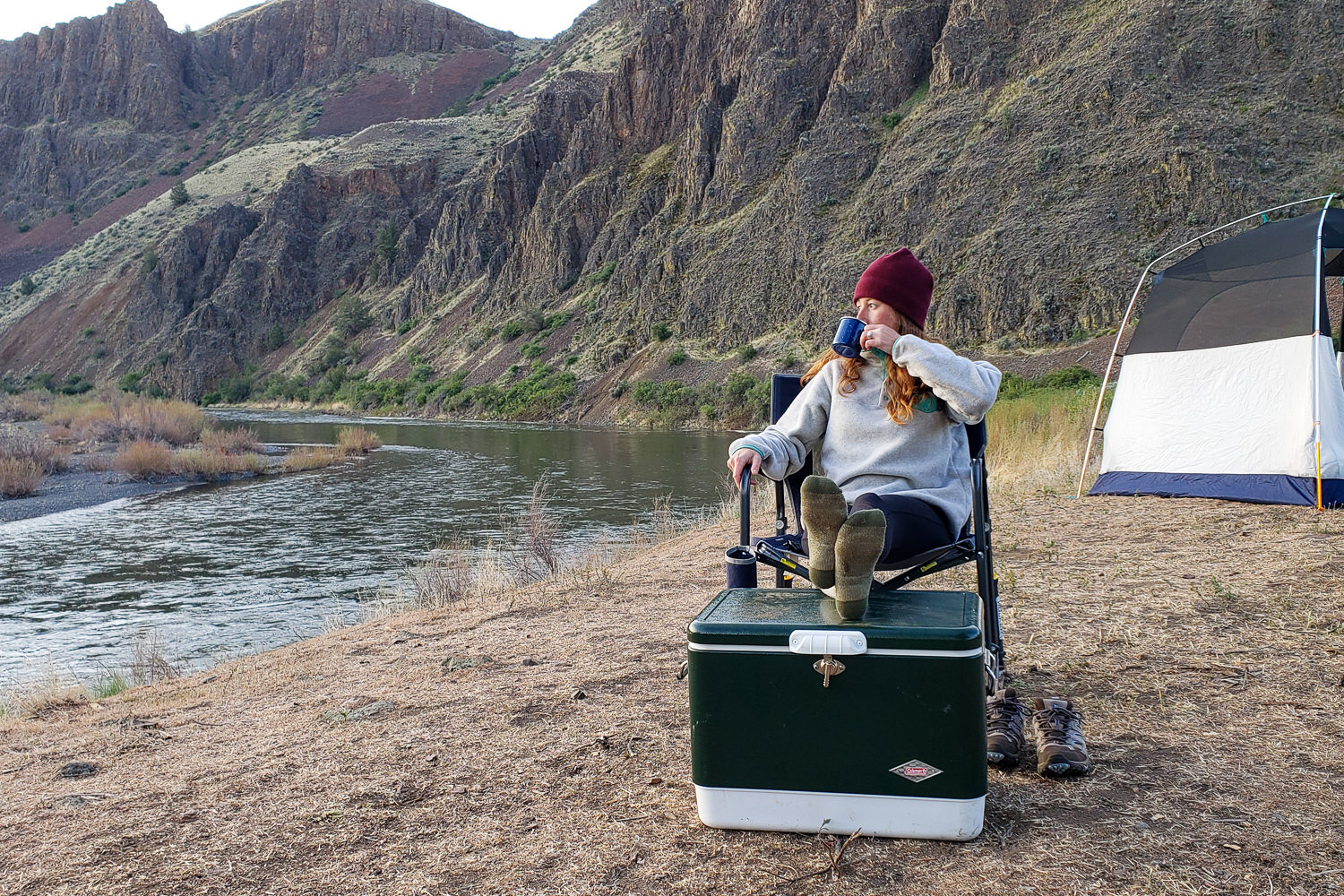
HOW LONG DO YOU NEED TO KEEP ITEMS COLD?
Our recommendations for what size cooler can accommodate trips of varying lengths are similar to those for the number of people a cooler is serving:
- Multi-Day Trip: 65 quarts or more
- Day Trip: 30 quarts or less
- Weekend Trip: 40-60 quarts
WHERE ARE YOU ADVENTURING?
Where will the cooler be used? Keeping items cold on a summer day in the desert looks different than at a picnic in a shaded park. Hotter temperatures speed up ice melt and cause a cooler to lose its chill faster, especially if there’s no place to store it out of direct sunlight. Coolers with higher-performing insulation, like rotomolded options, and design features such as lid gaskets and latches that keep the cooler closed and trap the cold are better suited for hot environments.
Burlier coolers made with durable, long-lasting materials are also recommended for rugged outdoor environments. Coolers constructed with single-piece plastic are less prone to damage from structural flaws and are designed to handle rough outdoor use. For those taking their cooler on multi-day camping trips or needing it to endure the elements, a heavy-duty cooler is a much better choice than more casual options. It will keep animals and weather out and will ultimately last over time.
Weight also matters when choosing where to use a cooler. With their thick layers of insulation, rotomolded coolers are heavier than other types. While they offer the best temperature control, the extra weight might not be worth carrying into more remote or difficult locations. Options like backpack-style coolers or those with wheels are great alternatives when heading to harder-to-reach places.
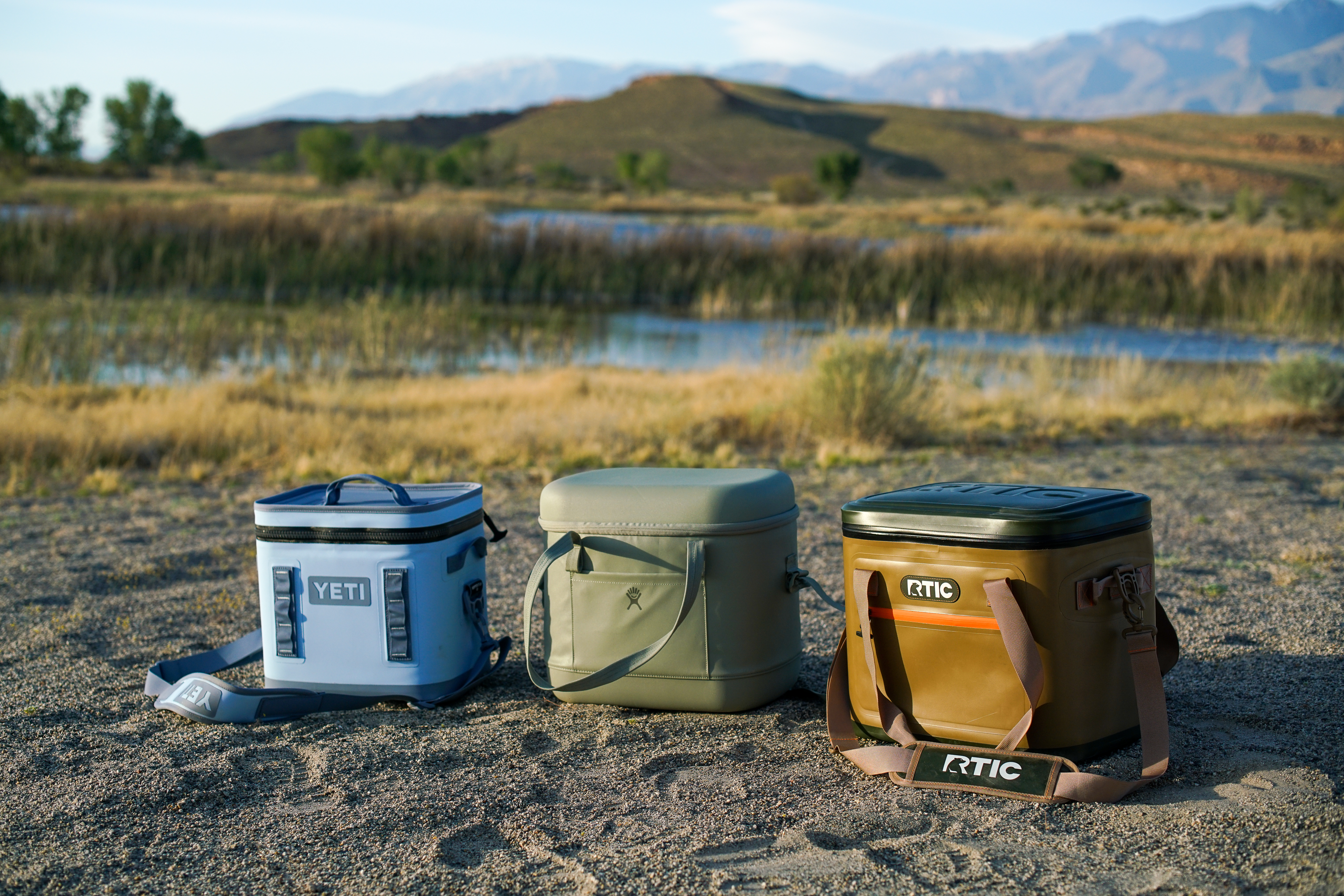
Conclusion
With so many coolers available on the market, it can be challenging to determine which will best meet your needs and keep items cold for as long as possible. Based on the results of our thorough testing outlined in this guide, our aim is to highlight some of the key factors that make a high-quality cooler. Our recommendations are supported by data and real-world use, and we hope they help you choose the right cooler to invest in.


